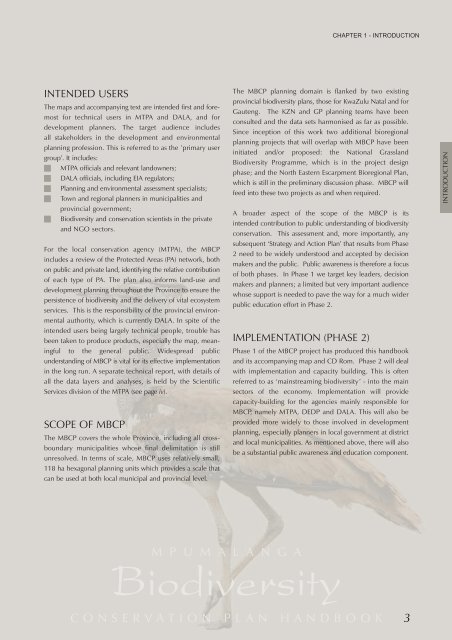Mpumalanga Biodiversity Conservation Plan Handbook - bgis-sanbi
Mpumalanga Biodiversity Conservation Plan Handbook - bgis-sanbi
Mpumalanga Biodiversity Conservation Plan Handbook - bgis-sanbi
Create successful ePaper yourself
Turn your PDF publications into a flip-book with our unique Google optimized e-Paper software.
INTENDED USERS<br />
The maps and accompanying text are intended first and foremost<br />
for technical users in MTPA and DALA, and for<br />
development planners. The target audience includes<br />
all stakeholders in the development and environmental<br />
planning profession. This is referred to as the ’primary user<br />
group’. It includes:<br />
MTPA officials and relevant landowners;<br />
DALA officials, including EIA regulators;<br />
<strong>Plan</strong>ning and environmental assessment specialists;<br />
Town and regional planners in municipalities and<br />
provincial government;<br />
<strong>Biodiversity</strong> and conservation scientists in the private<br />
and NGO sectors.<br />
For the local conservation agency (MTPA), the MBCP<br />
includes a review of the Protected Areas (PA) network, both<br />
on public and private land, identifying the relative contribution<br />
of each type of PA. The plan also informs land-use and<br />
development planning throughout the Province to ensure the<br />
persistence of biodiversity and the delivery of vital ecosystem<br />
services. This is the responsibility of the provincial environmental<br />
authority, which is currently DALA. In spite of the<br />
intended users being largely technical people, trouble has<br />
been taken to produce products, especially the map, meaningful<br />
to the general public. Widespread public<br />
understanding of MBCP is vital for its effective implementation<br />
in the long run. A separate technical report, with details of<br />
all the data layers and analyses, is held by the Scientific<br />
Services division of the MTPA (see page iv).<br />
SCOPE OF MBCP<br />
The MBCP covers the whole Province, including all crossboundary<br />
municipalities whose final delimitation is still<br />
unresolved. In terms of scale, MBCP uses relatively small,<br />
118 ha hexagonal planning units which provides a scale that<br />
can be used at both local municipal and provincial level.<br />
M P U M A L A N G A<br />
<strong>Biodiversity</strong><br />
CHAPTER 1 - INTRODUCTION<br />
The MBCP planning domain is flanked by two existing<br />
provincial biodiversity plans, those for KwaZulu Natal and for<br />
Gauteng. The KZN and GP planning teams have been<br />
consulted and the data sets harmonised as far as possible.<br />
Since inception of this work two additional bioregional<br />
planning projects that will overlap with MBCP have been<br />
initiated and/or proposed: the National Grassland<br />
<strong>Biodiversity</strong> Programme, which is in the project design<br />
phase; and the North Eastern Escarpment Bioregional <strong>Plan</strong>,<br />
which is still in the preliminary discussion phase. MBCP will<br />
feed into these two projects as and when required.<br />
A broader aspect of the scope of the MBCP is its<br />
intended contribution to public understanding of biodiversity<br />
conservation. This assessment and, more importantly, any<br />
subsequent ‘Strategy and Action <strong>Plan</strong>’ that results from Phase<br />
2 need to be widely understood and accepted by decision<br />
makers and the public. Public awareness is therefore a focus<br />
of both phases. In Phase 1 we target key leaders, decision<br />
makers and planners; a limited but very important audience<br />
whose support is needed to pave the way for a much wider<br />
public education effort in Phase 2.<br />
IMPLEMENTATION (PHASE 2)<br />
Phase 1 of the MBCP project has produced this handbook<br />
and its accompanying map and CD Rom. Phase 2 will deal<br />
with implementation and capacity building. This is often<br />
referred to as ‘mainstreaming biodiversity’ - into the main<br />
sectors of the economy. Implementation will provide<br />
capacity-building for the agencies mainly responsible for<br />
MBCP, namely MTPA, DEDP and DALA. This will also be<br />
provided more widely to those involved in development<br />
planning, especially planners in local government at district<br />
and local municipalities. As mentioned above, there will also<br />
be a substantial public awareness and education component.<br />
CONSERVATION PLAN HANDBOOK<br />
3<br />
INTRODUCTION

















